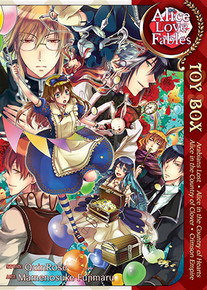Review
by Rebecca Silverman,Alice Love Fables: Toy Box
GN
| Synopsis: |  |
||
Divided into four sections, this collection of short stories explores the different romantic options available to the heroines of four QuinRose games: Arabians Lost, Alice in the Country of Hearts, Alice in the Country of Clover, and Crimson Empire. |
|||
| Review: | |||
Somehow, when reading Alice Love Fables: Toy Box, one gets the feeling that it might be more fun to just play the games. Comprising four chapters made up of three vignettes each, Toy Box is essentially a guide to some of the different routes available in four of QuinRose's otome games: Alice in the Country of Hearts, Alice in the Country of Clover, Crimson Empire: Circumstances to Serve a Noble, and Arabians Lost. Three of these we know – Seven Seas has been religiously releasing the two Alice titles in their many variations and also brought over the three volume Crimson Empire manga. These, therefore, are easier to understand and more palatable to English readers, as we at least know more or less who everyone is. Arabians Lost, on the other hand, is a total mystery, and it's difficult to find a whole lot to enjoy in the romances of people about whom we know next to nothing and, more importantly, have a backstory that we are not privy to. Thus it is that Toy Box stumbles right out of the gate. The first of the chapters takes place in this unknown story, making for a confusing start. Aileen, we are told, is the princess of a robber king, but just wants to be a normal girl, which is strange, since in a robber kingdom it might not be desirable to be on the other end of things. Her parents have given her a set amount of time to come up with a huge amount of money before they force her to marry the man of their choosing. The player, presumably, must do this while selecting one of the marriagable male options. Without a whole lot of background beyond this, we are thrown into three possible endings for Aileen. The fact that one involves Curtis, a character who is also present in Crimson Empire, makes one of the shorts much easier to get behind, simply because we know more about him, but we still don't know how he went from one tale to the other. Luckily one of the three relies more on situational romance than any understanding of the characters, and that short, the final in the chapter, is actually relatively easy to follow and get behind. The first, however, is almost a total loss. The other three chapters hold up better than the first. Alice in the Country of Clover is a bit more interesting than Alice in the Country of Hearts by virtue of giving us at least one storyline we have not read yet and which, as of this writing, has not yet been promised in longer form: that of Gray Ringmark, Nightmare's “assistant.” This is probably the strongest vignette in the whole book, giving us a more developed storyline than any of the others as well as offering an unfamiliar route, and throwing in some humor as a bonus. Another little seen pairing offered here is Alice and Peter, although this storiette does not receive the same length or level of detail as Gray's. The Crimson Empire chapter mostly suffers from the same issues which plague the longer series, first and foremost that it is never really believable that any of the characters truly care about each other. Sheila is not a loving personality, and unlike with Alice, little effort is made to get beneath her cynical (or in Sheila's case, crusty) exterior. The strongest piece in this chapter concerns the demon Michael Faust, and this is most successful in its bittersweet qualities...and in the fact that Sheila is not a character who really seems to want to be happy. QuinRose regular Mamenosuke Fujimaru provides all of the art for this volume, and she is not at her best. Several of the stories look to have been drawn a long time ago and are not up to her usual standard. Eyes are distinctly less detailed on all of the men, and bodies suffer from poor anatomy. Backgrounds tend to be replaced by screen tones, making it difficult to believe that all of the chapters take place in different settings. The Alice chapters are the best drawn, but even those are not up to the level of Fujimaru's other work. Alice Love Fables: Toy Box is the most skipable of all of the QuinRose works brought over to date. With one chapter a near total loss due to unfamiliarity with the source material, art that isn't as good as we normally see in the other franchises, and the sensation that we're just reading cheat sheets to the different possible game endings, this is not a particularly satisfying read. It does have its moments, like the Gray chapter, but overall, this is one journey that you needn't bother undertaking. |
|
The views and opinions expressed in this article are solely those of the author(s) and do not necessarily represent the views of Anime News Network, its employees, owners, or sponsors.
|
| Grade: | |||
Overall : D
Story : D
Art : C
+ Gray story is nicely done, it's kind of intriguing to get a glimpse of an unfamiliar series. Faust story is the most believable Crimson Empire tale to date. |
|||
| discuss this in the forum (3 posts) | | |||
| Production Info: | ||
|
Full encyclopedia details about Release information about |
||